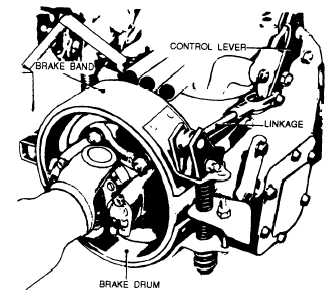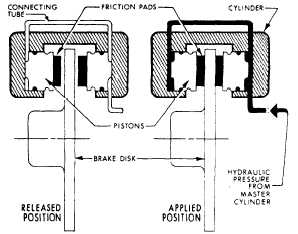Figure 3-40.-Internal expanding brake.
Figure 3-39.—External contracting transmission parking
brake.
Figure 3-39 shows an external contracting brake.
The brake band is anchored opposite the point where the
pressure is applied. In addition to supporting the band,
the anchor allows adjustment of the brake lining
clearance. Other adjusting screws and bolts are provided
at the ends of the band.
Internal Expanding Brakes
Internal expanding brakes are used almost
exclusively as wheel brakes, but can be found on some
cranes. This type of brake permits a more compact and
economical construction. The brake shoes and
brake-operating mechanism are supported on a backing
plate or brake shield attached to the vehicle axle, as
shown in figure 3-40. The brake drum, attached to the
rotating wheel, acts as a cover for the shoe and operating
mechanism and furnishes a frictional surface for the
brake shoes.
The brake shoe of an internal expanding brake is
forced outward against the drum to produce the braking
action. One end of the shoe is hinged to the backing plate
by an anchor pin, while the other end is unattached and
can be moved in its support by the operating mechanism.
When force from the operating mechanism is applied to
the unattached end of the shoe, the shoe expands and
brakes the wheel. A retracting spring returns the shoe to
the original position when braking action is no longer
required.
Disc Brakes
The disc brake has a metal disc (rotor) and a pair of
flat brake pads instead of a drum and curved brake
3-22
Figure 3-41.-Sectional view of a disc brake.
shoes. Figure 3-41 shows a sectional view of a disc
brake assembly. The two flat pads are on the two sides
of the disc. The assembly in which the flat pads are held
is the caliper assembly. In operation, the pads are forced
against the two sides of the disc by the movement of the
pistons in the caliper assembly. The pistons are actuated
by hydraulic pressure from the master cylinder. The
effect is to clamp the rotating disc between the stationary
pads, as shown in figure 3-41.
Mechanical Parking Brake
In most vehicles, a hand lever or foot pedal engages
the parking brake. The parking brake has its own
system and can be either an external contracting brake
bands on the drive shaft (fig. 3-42, view A) or a






